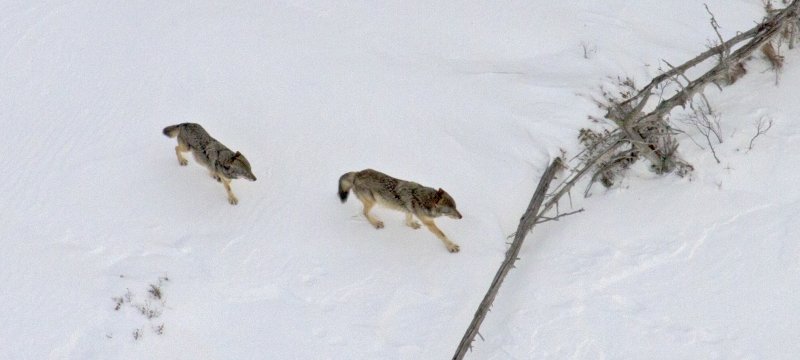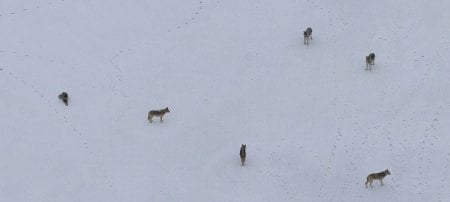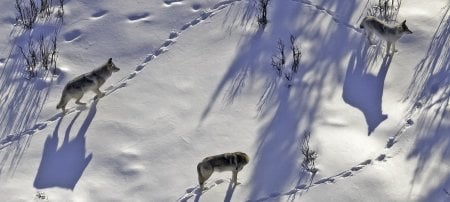On October 20, a ranger on his final hike for the season in Isle Royale National Park came across a dead wolf lying in the trail. An era ends and new packs may form.
Over the past year, the National Park Service and regional partners brought more than a dozen new wolves to Isle Royale as only two island-born wolves remained. This past fall, the park documented two wolf deaths — both caused by injuries inflicted by another wolf or group of wolves. One wolf was the male of the native pair.
To help document the shifting social hierarchies of the island, the 62nd Winter Study is underway in the Isle Royale National Park led by Michigan Technological University.
Population Biology
Monitoring wilderness takes a village. The snowy season’s collaborative effort builds off summer monitoring with the National Park Service and University of New York – College of Environmental Science and Forestry (SUNY-ESF).
“Rarely do we find dead wolves unless they are radiocollared,” said Rolf Peterson, a research professor in the College of Forest Resources and Environmental Science at Michigan Tech who co-leads the annual Isle Royale Winter Study. He helped park staff recover the carcass of the old male wolf, who was not radiocollared.
“His death, and finding the intact body so soon after, presents an extremely rare chance to study his genetics,” Peterson said. “Finally, his heritage will be clear and we will have a better understanding of the Isle Royale wolf story. Also, it remains to be seen what will happen with new packs forming.”
The male wolf was 11 years old and his mate, who was both his sister and daughter, is now nine years old. Based on necropsy results from the US Geological Survey’s National Wildlife Health Center, the cause of death was wolf-inflicted wounds. The pair had been the last remaining wolves on the island until the National Park Service introduced new wolves from Ontario, Minnesota and Michigan; these deaths and wolf-on-wolf aggression are not uncommon as wolves defend and establish their territories and social hierarchy. There are now 15 wolves on the island — seven females and eight males. The new wolves wear radio collars, so researchers track their movement as they explore the island.
Isle Royale Winter Study
The research from Isle Royale gives us a glimpse into the predator-prey dynamics and its impact on the island’s ecology: isleroyalewolf.org
With her mate gone, the female wolf may seek out a new partner, whose new offspring is unlikely to fall prey to the inbred genetics that crashed the original population. In partnership with the National Parks Service, Kristin Brzeski, assistant professor of wildlife ecology and genetics at Michigan Tech, will be studying the old male wolf’s genome. With an esteemed heritage — his grandmother was known as the Cinderella Wolf and his great grandfather The Old Grey Guy, two important wolves within the Isle Royale family tree — the male’s genes carry the story of genetic rescue and severe inbreeding, phenomena that are hard to study in the wild. Phil Hedrick from Arizona State University, a longtime collaborator on the Isle Royale project, will also be contributing to the research. A deeper understanding of the old packs’ downfall can help inform wildlife management and conservation decisions on the island and around the world.
“The wolves of Isle Royale have been showing us for some time now how the life of an individual animal can affect an entire ecosystem,” said John Vucetich, professor of ecology and another Winter Study co-lead. “The Old Grey Guy, who came across an ice bridge and introduced new genes into the population, and Cinderella, a notable alpha who survived a pack coup, are important examples. And the recovery of this carcass from the last known male wolf of the previous population may well prove to be another important example."
If the female does not choose a new mate, a power struggle may ensue as alpha contenders emerge and new packs form. The radio-collar movement patterns reveal wolves sharing bed sites, meals and hunting grounds as well as watching one another from a distance. Or rather listening: Wolves communicate territorial boundaries and pack identity through howling.
“The wolves are good at detecting vacancies,” Peterson said. “Anything could happen at this point. This year’s drama is just beginning.”
The next Winter Study report is expected to come out late in winter 2020 with an update on the wolves, moose population growth and health, small mammal populations and browsing impact on vegetation.
Michigan Technological University is a public research university founded in 1885 in Houghton, Michigan, and is home to nearly 7,500 students from more than 60 countries around the world. Consistently ranked among the best universities in the country for return on investment, Michigan’s flagship technological university offers more than 120 undergraduate and graduate degree programs in science and technology, engineering, computing, forestry, business, health professions, humanities, mathematics, social sciences, and the arts. The rural campus is situated just miles from Lake Superior in Michigan's Upper Peninsula, offering year-round opportunities for outdoor adventure.






Comments